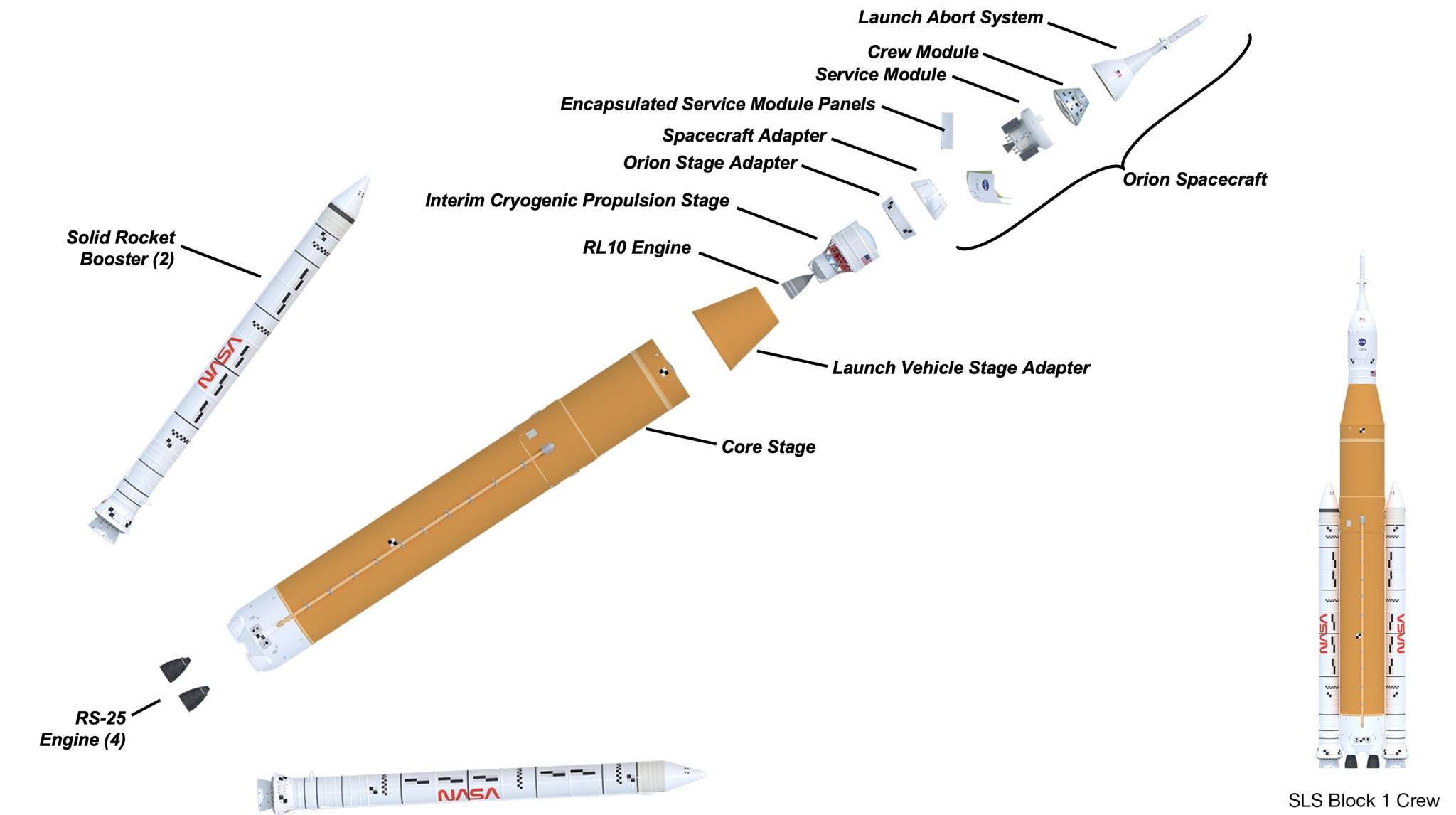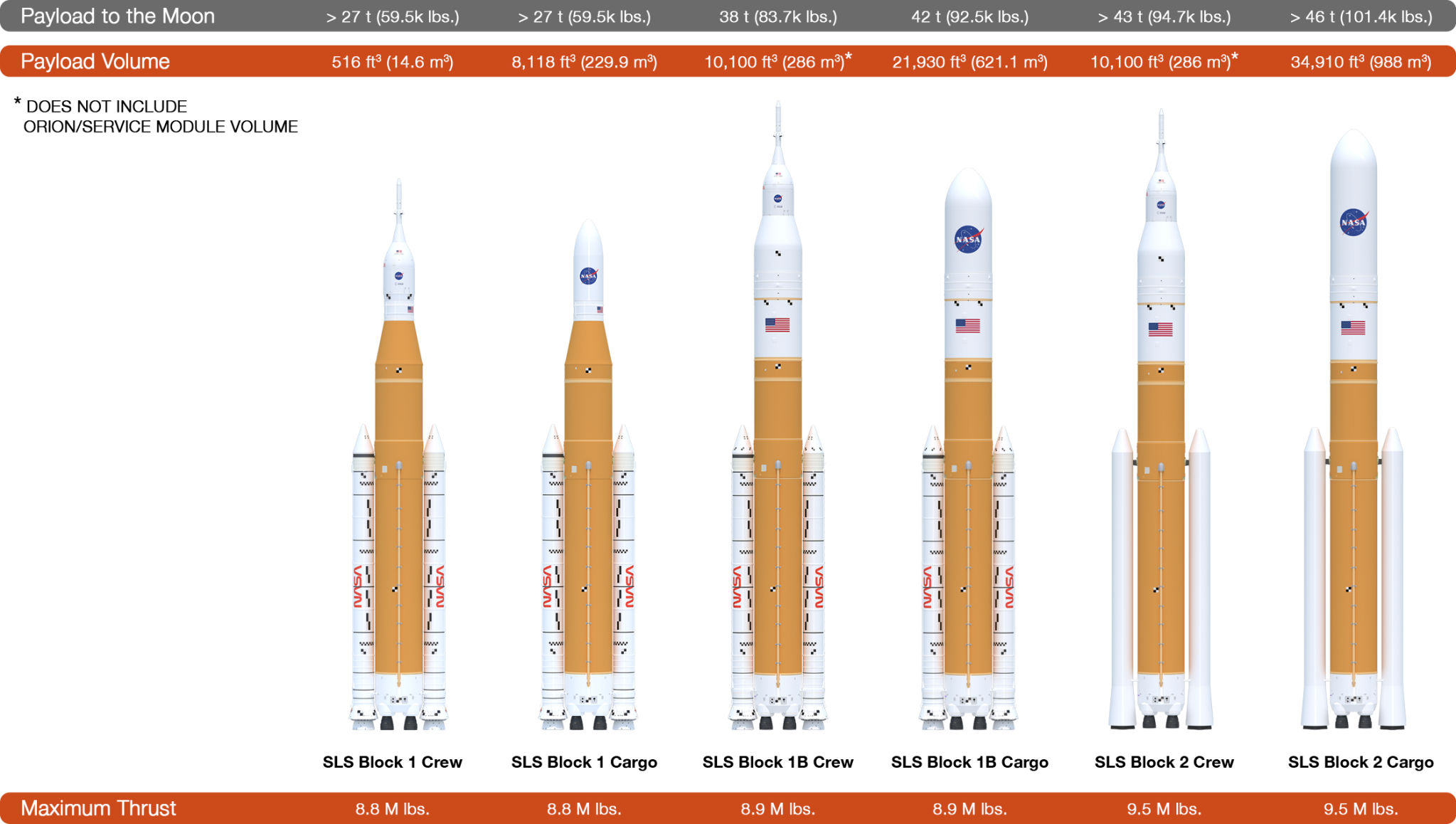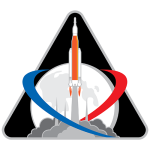Space Launch System
NASA’s SLS (Space Launch System) is a super heavy-lift rocket that provides the foundation for human exploration beyond Earth orbit. With its unprecedented capabilities, SLS is the only rocket that can send NASA’s Orion spacecraft, four astronauts, and large cargo directly to the Moon on a single launch.

America’s Rocket for Deep Space Exploration
NASA’s SLS (Space Launch System) is a super heavy-lift rocket that provides the foundation for human exploration beyond Earth orbit. With its unprecedented capabilities, SLS is the only rocket that can send NASA’s Orion spacecraft, four astronauts, and large cargo directly to the Moon on a single mission.
Offering more payload mass, volume, and departure energy than any other single rocket, SLS can support a range of mission objectives, while reducing mission complexity. The SLS rocket is designed to be evolvable, which makes it possible to increase its capability to fly more types of missions, including human missions to the Moon and Mars and robotic scientific missions to the Moon, Mars, and the outer planets.
On Nov. 16, 2022, SLS took to the sky from Launch Complex 39B at NASA’s Kennedy Space Center in Florida, making history as the most powerful rocket NASA has ever launched.
The successful Artemis I mission ushered in a new era of exploration, as NASA prepares to send astronauts to the Moon as a prelude to human exploration of Mars. Post-flight data
reviews determined that SLS met or exceeded performance expectations, and the rocket is ready to support a crewed flight on Artemis II and future crewed missions.
NASA is working to land the first woman, first person of color, and its first international partner astronaut on the Moon under the agency’s Artemis campaign. SLS is part of NASA’s backbone for deep space exploration, along with the Orion spacecraft, supporting ground systems, advanced spacesuits and rovers,
the Gateway in orbit around the Moon, and commercial human landing systems.
NASA is working to land the first woman, first person of color, and its first international partner astronaut on the Moon under the agency’s Artemis campaign. SLS is part of NASA’s backbone for deep space exploration, along with the Orion spacecraft, supporting ground systems, advanced spacesuits and rovers, the Gateway in orbit around the Moon, and commercial human landing systems.
The Power to Explore Beyond Earth’s Orbit
To fulfill America’s future needs for deep space missions, SLS will evolve into increasingly more powerful configurations. Hardware is currently in production for the next four SLS flights, and development is underway on the more powerful Block 1B and Block 2 variants that will succeed the current Block 1 variant.
SLS is designed for deep space missions and will send Orion or other cargo to the Moon, which is nearly 1,000 times farther than where NASA’s International Space Station resides in low Earth orbit. The high-performance rocket provides the power to help Orion reach a speed of 24,500 mph—the speed needed to send it to the Moon.
Every SLS configuration uses the core stage with four RS-25 engines. The first SLS variant, called Block 1, can send more than 27 metric tons (t) or 59,500 pounds (lbs.) to the Moon. It is powered by twin five-segment solid rocket boosters in addition to the four RS-25 liquid propellant engines. After reaching space, the ICPS (interim cryogenic propulsion stage) helps send Orion on to the Moon. Like Artemis I, the SLS rockets that will power Artemis II and III will use the Block 1 configuration.
The Block 1B crew vehicle will use a new, more powerful EUS (exploration upper stage) to enable more ambitious missions beginning with Artemis IV. The Block 1B rocket can, in a single launch, carry the Orion spacecraft along with large cargos needed to support a long-term presence on the Moon.
The Block 1B rocket can send 38 t (84,000 lbs.) to deep space, including Orion and its crew. Launching with cargo only, SLS has a large volume payload fairing to send larger exploration systems to the Moon and Mars or robotic science probes on solar system exploration missions.
The final SLS configuration, Block 2, will provide 9.4 million lbs. of launch thrust, compared to the Block 1’s
8.8 million lbs. and will be the workhorse vehicle for sending cargo to the Moon, Mars, and other deep space destinations. SLS Block 2 will be designed to lift up to 46 t (101,000 lbs.) to deep space. An evolvable design provides the nation with a rocket able to pioneer new human and robotic spaceflight missions.
Building the Rocket
NASA is building the rockets needed for several future missions. To reduce cost and development time, NASA is using existing proven hardware and designs from the space shuttle and other exploration programs while
making use of cutting-edge manufacturing technology and inspection techniques such as 3D printing and structured light scanning.
Some parts of the rocket are new, and other parts have been upgraded with modern features that meet the needs of deep space missions, which require higher performance levels.
Core Stage
The Boeing Company in Huntsville, Alabama, is the lead contractor for SLS core stage manufacturing, including the flight computers that control the rocket during flight. Towering more than 212 feet with a diameter of 27.6 feet, the core stage stores 733,000 gallons of super-cooled liquid hydrogen and liquid oxygen that power the RS-25 engines.
Core stages are built at NASA’s Michoud Assembly Facility in New Orleans using state-of-the-art manufacturing equipment, including a friction stir welding tool that is the largest of its kind in the world. The core stage is the newest part of the rocket.
Boeing is building stages for several upcoming Artemis missions. The SLS avionics computer software is developed at NASA’s Marshall Space Flight Center in Huntsville, Alabama.
RS-25 Engines
Propulsion for the SLS core stage will be provided by four RS-25 engines powered by liquid hydrogen and liquid oxygen. Aerojet Rocketdyne, an L3Harris Technologies company, of Sacramento, California, is upgrading an inventory of 16 RS-25 engines to SLS performance requirements, including a new engine controller, nozzle insulation, and required operation at a maximum of
512,000 lbs. of thrust. The four engines provide about 2 million lbs. of thrust for the eight-minute climb to Earth orbit.
The NASA SLS Program and Aerojet Rocketdyne began test firing heritage space shuttle engines in 2016 using SLS thrust profile and operating environments. The tests included new engine controllers and software,
added nozzle insulation for the higher launchpad heating environment, and several new production engine components. By the time Artemis I launched, the test program had amassed 52 tests for 23,171 total seconds.
Aerojet Rocketdyne has also restarted engine production with the goal of a 30% cost reduction compared to the shuttle RS-25. It is currently building 24 engines. In early 2024 at NASA’s Stennis Space Center in Bay St. Louis, Mississippi, the engine team completed a comprehensive test firing program to certify new-production engines for flight, beginning with Artemis V.
Boosters
Two shuttle-derived solid rocket boosters provide more than 75% of the rocket’s thrust during the first two minutes of flight. The prime contractor for the boosters, Northrop Grumman’s Northern Utah team, has modified the original configuration of four propellant segments to a more powerful five-segment version. Each modified booster is 177 feet tall, 12 feet in diameter, weighs 1.6 million pounds, and produces a maximum of 3.6 million pounds of thrust during launch. The design also includes new avionics, propellant grain design, and case insulation, and eliminates the recovery parachutes to allow greater payload to orbit.
The company has completed motor segments for the Artemis II and Artemis III missions and is working on boosters for future missions. Trains transport booster segments from the Utah plant to Kennedy, where they are stacked with forward and aft assemblies to create the largest, most powerful boosters ever flown for spaceflight. The boosters’ avionics systems are tested at Kennedy and Marshall.
Integrated Spacecraft/Payload Element
The initial capability to propel Orion out of Earth’s orbit for the first three Artemis missions is provided by the interim cryogenic propulsion stage, based on the Delta Cryogenic Second Stage used successfully on United Launch Alliance’s Delta IV family of rockets.
The Orion stage adapter connects Orion to the ICPS on the SLS Block 1 rocket. The Orion stage adapter can accommodate several CubeSat payloads in 6U or 12U sizes, depending on mission parameters.
For Artemis I, the adapter carried several 6U-sized CubeSats to deep space for various science and technology demonstration missions.
Exploration Upper Stage
Beginning with Artemis IV, the ICPS will be replaced by the exploration upper stage under contract to Boeing.
It is powered by four RL10C-3 engines that produce almost four times more thrust than the one RL10B-2 engine that powers the ICPS. This 97,000 lbs. of thrust will allow more than 38 t (84,000 lbs.) for Block 1B crew and more than 42 t (93,000 lbs.) for Block 1B cargo to be sent to the Moon.
With the EUS plus a new 10,000-cubic-foot universal stage adapter, NASA can use a Block 1B crew configuration to send Orion, astronauts, and large, unique payloads to the Moon or replace the Orion and universal stage adapter with a payload fairing to send nearly 22,000 cubic feet of payload to the Moon, Mars, or more distant destinations.
NASA completed the critical design review for the EUS in 2019. Boeing is building the EUS at Michoud. Aerojet Rocketdyne has completed manufacturing and testing of several engines.
The SLS Team
SLS is America’s rocket with more than 1,100 companies from across the U.S. and at every NASA center supporting the development of the world’s most capable rocket.
The SLS Program, managed at Marshall, works closely with the Orion Program, managed at NASA’s Johnson Space Center in Houston, and the Exploration Ground Systems Program, managed at Kennedy.
National Aeronautics and Space Administration
George C. Marshall Space Flight Center Huntsville, AL 35812 www.nasa.gov/marshall
For more information about SLS, visit: http://www.nasa.gov/artemis http://www.nasa.gov/sls http://www.twitter.com/NASA_SLS http://www.facebook.com/NASASLS http://www.instagram.com/nasaartemis

































